Bhadralok
| Part of a series on the |
| Culture of Bengal |
|---|
|
|
Traditions
|
|
|
|
History
Genres
Institutions
Awards
|
|
Music and performing arts |
|
Media
|
|
Sport
|
|
| Part of a series on the |
| Culture of Bangladesh |
|---|
|
People
|
|
|
Traditions
|
|
|
| Religion |
|
Art |
|
Literature History
Genres
Institutions Awards Writers
|
|
Music and performing arts |
|
Media
|
|
|
Monuments |
|
| Part of a series on the |
| Culture of India |
|---|
 |
| History |
| People |
| Cuisine |
| Religion |
|
Art
|
|
Literature |
|
Music and performing arts
|
|
Media |
| Sport |
|
Monuments |
|
Bhadralok (Bengali: ভদ্রলোক bhôdrôlok, literally 'gentleman', 'well-mannered person'"paper saints") is Bengali for the new class of 'gentlefolk' who arose during British colonial times (approximately 1757 to 1947) in Bengal.
Caste and class makeup
Most, though not all, members of the bhadralok class are upper caste, mainly Baidyas, Brahmins and Kayasthas. There is no precise translation of bhadralok in English, since it attributes economic and class privilege on to caste ascendancy. However, many bhadraloks in the nineteenth century came from an underprivileged Brahmin or Priest caste or middle level merchant class (such as Rani Rashmoni)(She was a Kaibartta by caste, Ramakrishna often expressed his dissent calling her as such, kaibarttani). Anybody who could show considerable amount of wealth and standing in society was a member of the bhadralok community.
The bhadralok community includes all gentlefolk belonging to the rich as well as middle class segments of the Bengali society. Amongst the upper middle classes, a zamindar, or landowner, normally bearing the title Chaudhuri or Roy Chaudhuri at the end of the name, and Babu at the beginning would be considered to be a bhadralok. A zamindar bearing the title Raja or Maharaja would be considered to be higher than middle class, but would still be a bhadralok 'gentleman'. All members of the professional classes, i.e. those belonging to the newly emerging professions, such as doctors, lawyers, engineers, university professors, and higher civil servants, were members of the bhadralok community. However, an individual bearing the title Esquire at the end of the name, denoting a rank just below a Knight, was also considered to be higher than a bhadralok.
Colonial factors
The two biggest factors that led to the rise of the bhadralok were the huge fortunes many merchant houses made from aiding the English East India Company's trade up the Ganga valley, and Western-style education (at the hands of the colonial rulers and of missionaries). The steep rise in real estate prices in Calcutta also led some petty landlords in the area to become wealthy overnight. The first identifiable bhadralok figure is undoubtedly Ram Mohan Roy, who bridged the gap between the Persianised nobility of the Sultanate era in Bengal and the new, Western-educated, nouveau riche comprador class.
The Bengal Renaissance
The Bengal Renaissance was largely carried out and participated in by bhadralok. In addition, the rise of the Brahmo Samaj and various other samajes (a category halfway between 'society' and 'community') was also largely a bhadralok phenomenon. To be a bhadralok was to embrace some Western and Northern European values (though not always the same ones in each case), to have a modicum of education, and a sense of entitlement to (and consequently grievance against) favours or employment from the colonial government. While the bhadralok were influenced by the West (in terms of their morals, dress, and eating habits) they were also the people who reacted most strongly against the West, and the most scathing critiques as well as the most spirited defences of Westernisation were made by bhadralok writers.
Babus
The term Babu means an individual of rank and dignity. It is most commonly used to refer to gentleman, but is meant for anybody who enjoys a position of dominance in his immediate social circle. An Indian zamindar as well as an Indian member of the higher government services was referred to as a Babu. Amongst the landlords a Babu in the former Bengal Presidency, especially in Bengal and Behar, was normally a substantial and extremely wealthy zamindar in the same rank as a Thakur or a Mirza, and would rank just below a Raja. The term Babu has been historically used to refer to the upper echelons of the Indian society, including the ruling classes.
In the colonial period the term was derogatorily used to refer to members of the indigenous community, especially in law courts and revenue establishments in the late eighteenth and early nineteenth centuries, where most members were appointed as Munsifs from respectable and/or zamindari families.
See also
References
- Subho Basu and Sikata Banerjee, 'The Quest for Manhood: Masculine Hinduism and Nation in Bengal in Comparative Studies of South Asia, Africa and the Middle East
- Banglapedia article on bhadralok
- Indira Choudhuri, The Fragile Hero and Virile History: Gender and the Politics of Culture, (New Delhi: Oxford University Press, 1998).
- Tithi Bhattacharya, The Sentinels of Culture: Class, Education and the Colonial Intellectual in Bengal, (New York: Oxford University Press, 2007).